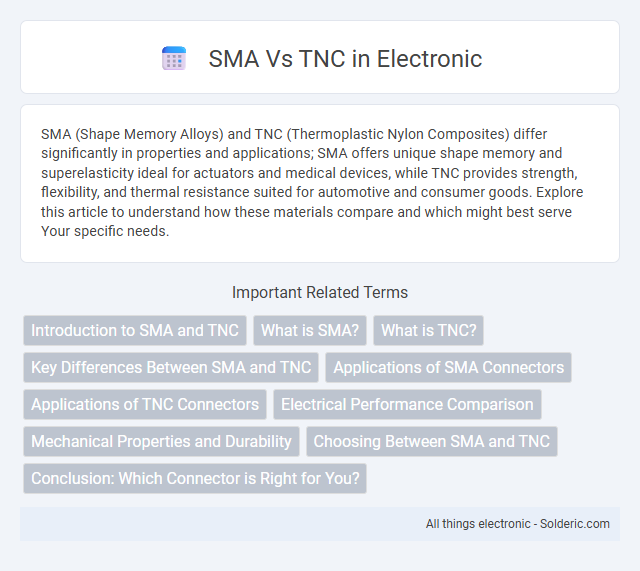SMA (Shape Memory Alloys) and TNC (Thermoplastic Nylon Composites) differ significantly in properties and applications; SMA offers unique shape memory and superelasticity ideal for actuators and medical devices, while TNC provides strength, flexibility, and thermal resistance suited for automotive and consumer goods. Explore this article to understand how these materials compare and which might best serve Your specific needs.
Comparison Table
| Feature | SMA Connector | TNC Connector |
|---|---|---|
| Type | SubMiniature version A | TNC: Threaded Neill-Concelman |
| Frequency Range | Up to 18 GHz (standard) | Up to 11 GHz |
| Impedance | 50 ohms | 50 ohms or 75 ohms (less common) |
| Coupling Mechanism | Threaded (1/4 turn) | Threaded (screw-on) |
| Size | Smaller, compact | Larger, bulkier |
| Durability | Moderate, precision applications | Robust, weatherproof suitable |
| Applications | RF, microwave systems, antennas | Military, aerospace, outdoor RF |
| Gender | Male plug has external threads | Male plug has internal threads |
Introduction to SMA and TNC
Shape Memory Alloys (SMA) are metal alloys that return to a predetermined shape when heated, widely used in medical devices and actuators due to their unique thermoelastic properties. Thermo-Responsive Nanocomposites (TNC) consist of nanomaterials embedded in polymers that undergo structural or property changes upon temperature variation, making them ideal for smart materials and sensors. Both SMA and TNC exhibit temperature-driven responses but differ fundamentally in composition, mechanism, and application scope.
What is SMA?
Shape Memory Alloys (SMA) are metal alloys, typically composed of nickel and titanium (NiTi), that can return to a predetermined shape when heated after deformation. These materials exhibit unique properties such as superelasticity and the shape memory effect, making them valuable in applications ranging from medical devices to aerospace components. SMA's ability to undergo reversible phase transformation between martensite and austenite phases under thermal or mechanical stimuli differentiates them from traditional metals like Thermo-Mechanical Nickel-Cobalt (TNC) alloys.
What is TNC?
TNC stands for Transnational Corporation, a large company that operates in multiple countries with centralized headquarters but manages production, marketing, and services across borders. TNCs leverage global supply chains and economies of scale to optimize efficiency and market reach. Compared to SMA (Small and Medium-sized Enterprises), TNCs have significantly greater economic influence and resources, shaping international trade and investment patterns.
Key Differences Between SMA and TNC
SMA connectors feature threaded coupling mechanisms that provide secure and reliable connections for high-frequency signals, commonly used in RF applications up to 18 GHz. TNC connectors use a similar threaded design but include a larger size and a weatherproof seal, making them ideal for outdoor and rugged environments, supporting frequencies up to 11 GHz. The primary differences lie in size, frequency range, and environmental resistance, with SMA connectors favored for precision and compactness while TNC connectors excel in durability and moisture resistance.
Applications of SMA Connectors
SMA connectors are widely used in microwave systems, antennas, and RF components due to their high-frequency performance up to 18 GHz. These connectors are ideal for precise, low-loss signal transmission in telecommunications, aerospace, and test equipment applications. Their compact size and threaded coupling mechanism ensure reliable connections in environments requiring durable, high-frequency interconnects.
Applications of TNC Connectors
TNC connectors are widely used in applications requiring reliable, weatherproof RF connections, including outdoor wireless communication systems, cellular networks, and GPS devices. Their threaded coupling mechanism ensures a secure, vibration-resistant connection ideal for industrial and military environments. When selecting connectors for your equipment, TNC connectors provide enhanced durability and performance in high-frequency applications compared to SMA connectors.
Electrical Performance Comparison
SMA connectors exhibit superior electrical performance in terms of low return loss and stable impedance up to 18 GHz, making them ideal for high-frequency applications. TNC connectors provide reliable electrical performance with lower sensitivity to vibration and a frequency range typically up to 11 GHz, suitable for robust RF environments. The choice between SMA and TNC connectors depends on the specific frequency requirements and environmental conditions of the application.
Mechanical Properties and Durability
SMA (Styrene Maleic Anhydride) exhibits superior mechanical properties such as high tensile strength and flexibility, making it ideal for applications requiring impact resistance. TNC (Thermoplastic Nylon Composite) offers excellent durability with enhanced wear resistance and thermal stability, suitable for long-term use in demanding environments. Your choice between SMA and TNC should consider the specific mechanical stress and environmental exposure of your project to ensure optimal performance.
Choosing Between SMA and TNC
Selecting between SMA and TNC connectors depends largely on frequency range and environmental conditions. SMA connectors support frequencies up to 18 GHz with excellent performance in high-frequency applications, while TNC connectors, designed for rugged environments, operate effectively up to 11 GHz and provide superior moisture resistance. Evaluate the specific antenna or device requirements, considering factors like signal loss, installation location, and durability before making a decision.
Conclusion: Which Connector is Right for You?
Choosing between SMA and TNC connectors depends on your specific application requirements and environmental conditions. SMA connectors offer superior performance at higher frequencies with excellent precision, making them ideal for applications like RF and microwave systems. TNC connectors provide robust durability and better resistance to moisture, suitable for outdoor or harsh environments, ensuring your connection remains reliable under challenging conditions.
SMA vs TNC Infographic

 solderic.com
solderic.com